By LAVENDER AU
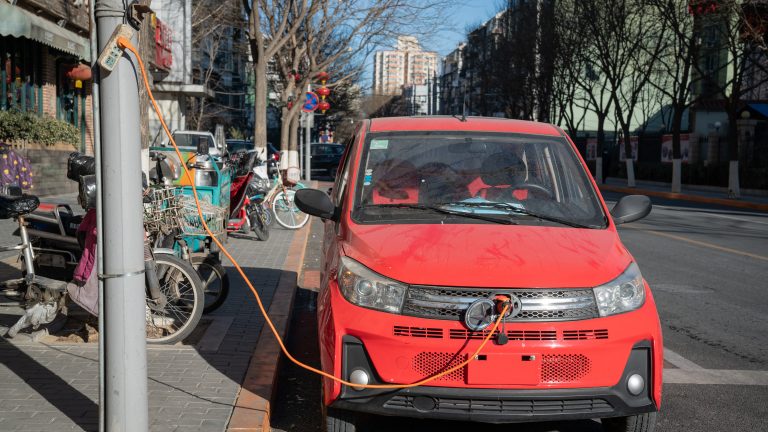 In Beijing’s southwestern outskirts, past a four-lane overpass with sidewalks as wide as the streets themselves, is Zhengyang Road. It has the usual banks, small convenience stores, and noodle houses of many areas in the capital, but it is set apart by a row of about a dozen shops all selling the same thing — tiny electric cars. The cars look, variously, like small Range Rovers, golf carts, trolley cars, or rickshaws with sheet-iron sides, and they are slow. Their fundamental attraction is their price — between $600 and $2,500 — and that drivers can charge them the same way they would a cell phone. They also come with the perks of being loosely regulated. These low-speed electric cars, nicknamed “elderly transport vehicles,” have an enormous market, made up mostly of people who earn very little. And in China, there are a lot of them — more than 40% of the population, or some 600 million people, make around $150 per month.
In Beijing’s southwestern outskirts, past a four-lane overpass with sidewalks as wide as the streets themselves, is Zhengyang Road. It has the usual banks, small convenience stores, and noodle houses of many areas in the capital, but it is set apart by a row of about a dozen shops all selling the same thing — tiny electric cars. The cars look, variously, like small Range Rovers, golf carts, trolley cars, or rickshaws with sheet-iron sides, and they are slow. Their fundamental attraction is their price — between $600 and $2,500 — and that drivers can charge them the same way they would a cell phone. They also come with the perks of being loosely regulated. These low-speed electric cars, nicknamed “elderly transport vehicles,” have an enormous market, made up mostly of people who earn very little. And in China, there are a lot of them — more than 40% of the population, or some 600 million people, make around $150 per month.On a Sunday afternoon in October, Zhengyang Road is filled with potential customers chatting with store owners. Outside a shop with a worn sign, a young couple with a child are in the midst of a heated conversation. They came on an electric scooter and are debating whether to leave with a tiny car.
“Don’t we need one for school pickups?” the woman argues. “The children won’t have to put up with the cold in winter.” Her scooter offers no protection from the weather other than oven-mitt-like gloves secured to its handlebars. Her husband counters, “The 1,000 renminbi [$150] quote was for normal batteries, but lithium ones can be five times that. Can’t you just add a windshield to your scooter instead?” The shop owner shows them a cheaper model — which is cheaper because it has no roof. He suggests putting a plastic covering on top.
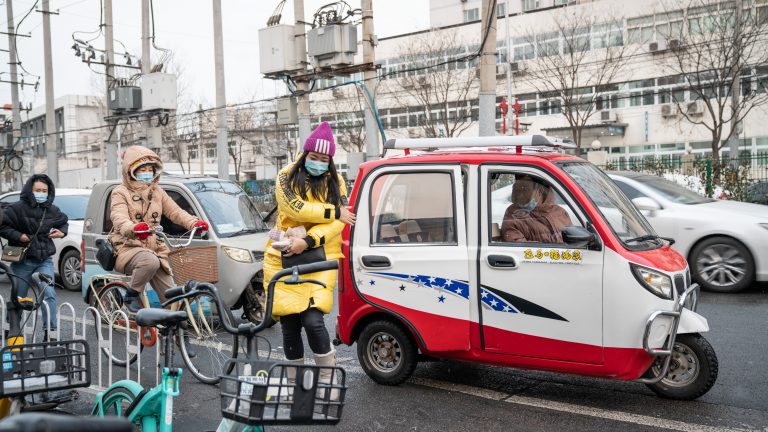 Tiny cars are less that 1.5 meters in length, and their top speed is between 40 and 56 kilometers an hour.
Tiny cars are less that 1.5 meters in length, and their top speed is between 40 and 56 kilometers an hour.Having decided that the future of mobility is electric, the Chinese government has subsidized sales of standard electric cars since 2010. With close to 1.18 million sold in 2019, China accounts for just over half of electric-vehicle sales globally. Bill Russo, founder and CEO of advisory firm Automobility Limited, sees a “steady and solid rise” in China’s electric-vehicle sales generally. The country has set a top-down target for electric vehicles to make up 40% of car sales by 2030, and Russo thinks they’ll have no problem hitting this goal. Tiny cars, which first began appearing in the early 2010s, have more than double the sales of regular electric cars but have never benefited from subsidies. Nor do advertisements for them air on television — instead, they appear on Kuaishou, a short-video platform popular with people living outside China’s big cities. Alongside streamers selling plums by the thousands, and others telling viewers what long-haul trucker life is like, drivers show off their tiny cars. Su Hua, Kuaishou’s founder, has long maintained that his app’s users are not “cool,” unlike those on Douyin, the TikTok predecessor popular with China’s urban elite. Rather, they are ordinary — the kind of people who might be in the market for miniature cars.
As they don’t technically require licenses, tiny cars tend to be popular with migrant workers, who struggle to pay for driving lessons and other car-related costs. The elderly, too, find tiny cars attractive since, up until October of last year, people over 70 could not apply for a driving license in China. They’re also convenient for anybody who wants a car to pick up groceries or their kids from school: No tiny car is longer than 1.5 meters, and their speed tops out at between 40 and 56 kilometers an hour. They’re for the short trips of daily life, not for traveling from one side of the city to another.
Some cities have banned sales of tiny cars — Beijing did so in 2018. Their production isn’t regulated by the government, and since they can’t be insured in many parts of China, it can be difficult for other drivers to get a payout if a tiny car is involved in an accident. Because tiny-car drivers don’t need to take a driving test, other drivers complain, they often go the wrong way and weave in and out of traffic. But since enforcement is lax, sales have quietly resumed in Beijing over the past two years. These little electric cars now exist in a kind of regulatory gray zone.



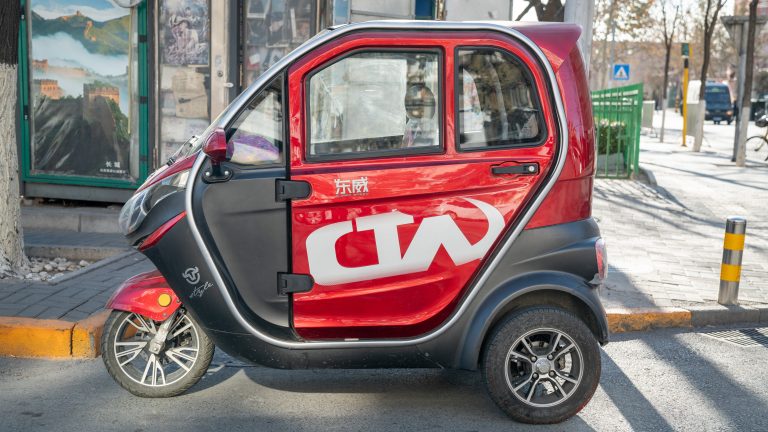
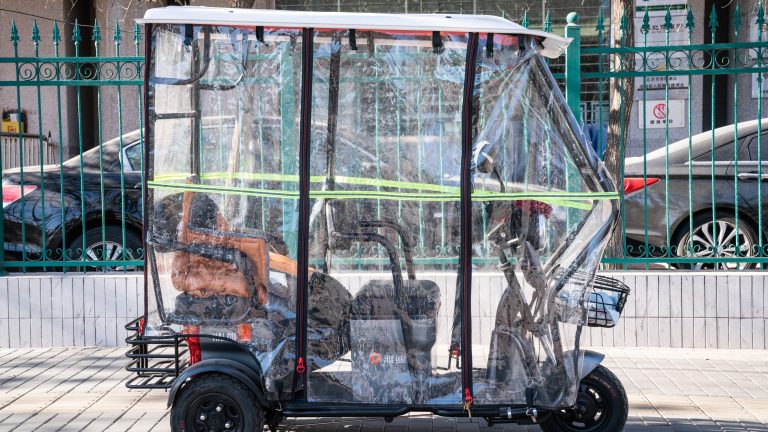
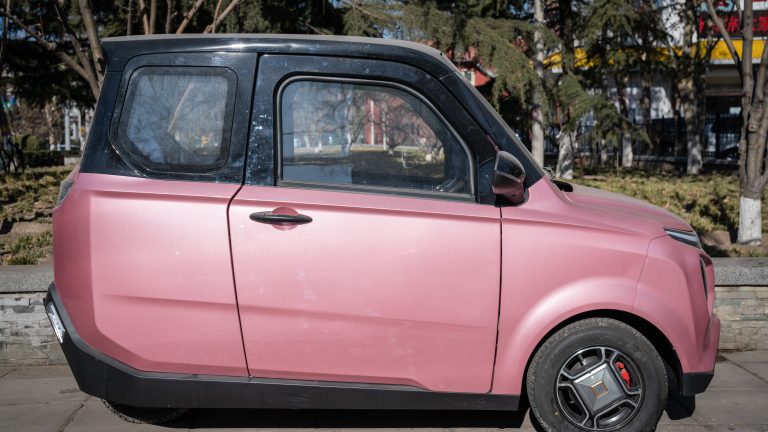
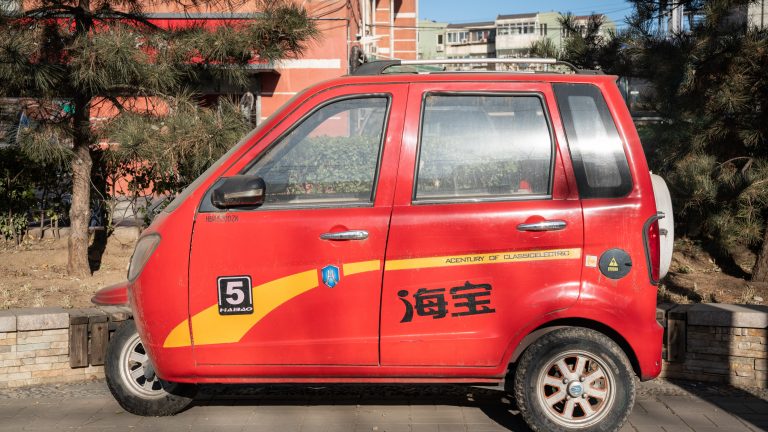
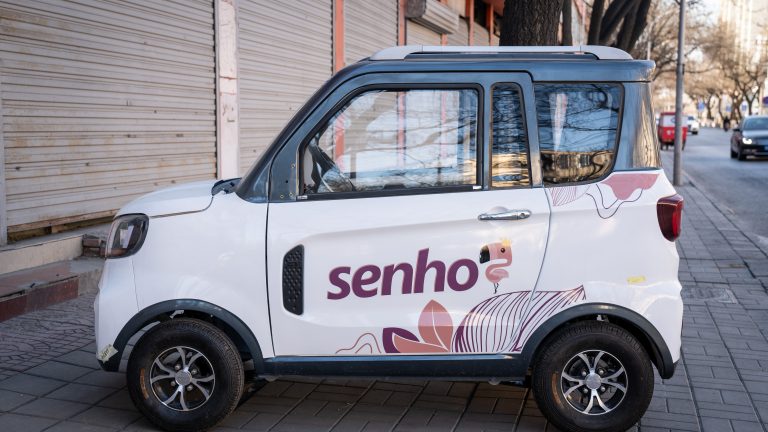 Tiny cars come in a variety of styles and cost between $600 and $2,500.
Tiny cars come in a variety of styles and cost between $600 and $2,500.One of the smaller shops on Zhengyang Road is officially known as Xinlei Scooters, its name emblazoned in white characters on a large red sign above its doors. But inside, past rows of electric scooters, is a smaller, flimsier plaque above the counter announcing its other name: Shitou Cars. This subterfuge is necessary because the police could shut down the operation and confiscate its vehicles if the owners were caught selling tiny cars. Yet because enforcement hasn’t been strict of late, attempts at being covert go only so far: There are several tiny cars parked outside, an open-air showroom.
Xinlei/Shitou’s owner is a middle-aged man with pronounced cheekbones wearing a black tracksuit. He is more attentive to the phone calls he’s constantly receiving than the customers in the shop. It is his wife, with dyed-dark-brown hair and a pink coat, who maintains the sales patter: “I taught an auntie who had never driven a car before. She got the hang of it in three days.” She shows the cars outside to potential customers, opening their doors, instructing people to sit inside, and rolling down the windows. When two old men come in for repair services, her husband finally gets off the phone to deal with them. Meanwhile, two government functionaries in black uniforms pace down the street. They tell one owner to make his storefront tidier, but otherwise overlook the illicit operation.
Part of the reason why tiny cars are so popular is because there has not been an official decision on whether they need license plates. For regular cars, unfettered access to Beijing’s inner city — anywhere within the fifth ring road — is restricted to vehicles with Beijing plates. Licenses for gas cars are distributed through a special system so competitive that it has generated its own black market. License-plate holders can collect up to $2,700 a year by renting them to those who want to drive in the city. In addition to government subsidies, getting around some of the more onerous aspects of the licensing system is one of the main selling points for standard electric cars.
With Beijing temperatures reaching lows of 4 degrees Celsius in wintertime, Xinlei/Shitou has been selling, on average, two of its four-wheeled fully enclosed models every day, a saleswoman boasts. Younger couples prefer four wheels, she adds, while older people usually want three. When asked about the possibility of a tiny car being confiscated, she draws in a breath. “Don’t go on the main roads. Don’t make a business out of it,” she advises.
At least one of Zhengyang Road’s customers isn’t listening: Guo Caiying, who works primarily in the construction-supply industry, chauffeurs Fengtai residents around her district. She has a sticker on her tiny car’s back window with the phone number of her car dealer. Guo’s car looks like a golf cart, with cushioned brown seats enclosed by windows. A red fudai, a lucky charm, swings from the ceiling, its characters spelling out “peace.” There is enough space for two people to comfortably sit upright but not enough to extend your legs without hitting the plexiglass divider between driver and passenger. The car tops out at 40 kilometers an hour, and as a result, Guo never ventures beyond Fengtai — a borderland where urban and rural meet.
Guo wears the uniform of the countryside: a padded jacket. She is from Henan, a province 800 kilometers southwest of Beijing, and speaks its dialect. Guo starts taking calls from her regulars around 7 a.m., arriving at their door whenever they want to be picked up. She stops driving at 9 a.m., when the traffic police begin work. She characterizes her customers as “people with money who sit in offices.” Once, while in the middle of a trip, Guo saw a cop stop a car like hers. She kept driving, but dropped her passenger off before their destination. Now, if a customer calls her after 9:00, she sends her husband to pick them up with his electric scooter. He charges 75 cents (5RMB), which is half her price. Guo’s flat rate was fixed by the tiny-cab drivers who preceded her.
The economy of tiny cars depends on such informal practices. When asked whether she would consider undercutting other drivers, Guo is adamant. “No one can break the rules,” she says. There are local WeChat groups for tiny-car drivers that new owners are inducted into upon purchasing one. Within these groups, members swap information on the whereabouts of local cops and whether anyone has been fined or had their car taken away.
Despite the risks, Guo still thinks it’s worth being a tiny-car driver to make a little pocket money. Tiny cars are part of a last-mile economy that flourishes at the beginning and end of the workday. Many Fengtai residents are employed at the local high-tech park, which is host to thousands of businesses. It takes 20 minutes to walk from one end of the park to the other, a trip many would rather make by tiny car. The cars’ main competitors are share bikes, which are cheaper but lack space for luggage and can’t be split with a friend. Tiny cars are also more social — a feature Guo tries to capitalize on. She strikes up conversations with her customers, encouraging them to add her on WeChat or take her telephone number, so she can come straight to their door.
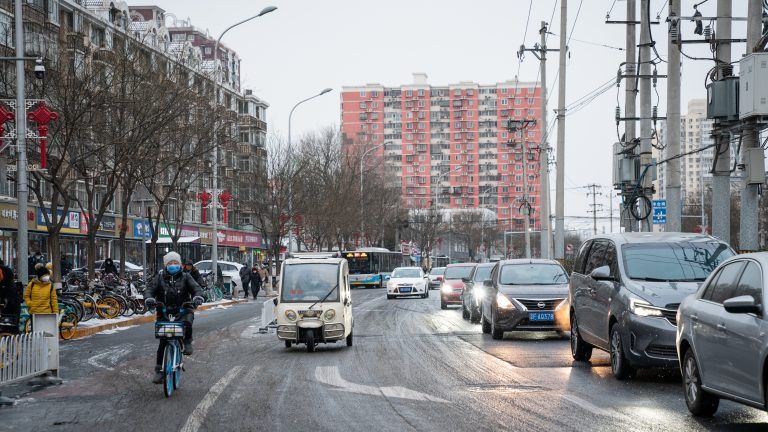
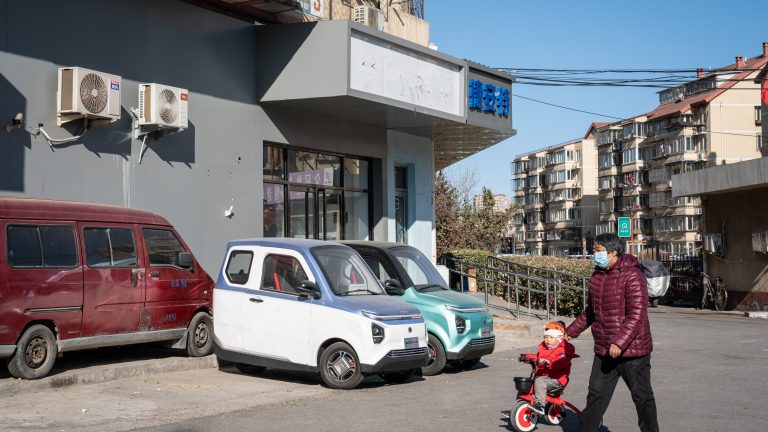
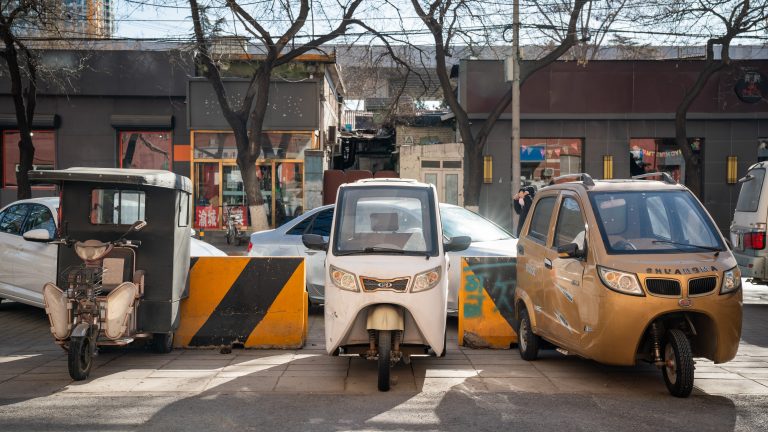 Beijing banned the sale of tiny cars in 2018, but sales have quietly resumed over the past two years as authorities have chosen to look the other way.
Beijing banned the sale of tiny cars in 2018, but sales have quietly resumed over the past two years as authorities have chosen to look the other way.The greatest fear among people in China’s tiny-car economy is that one day their vehicles will be banned. But Wang Jun, who designs tiny cars, has never been worried. “Just because they’re in a gray area, it doesn’t mean the government ignores them,” he says. They’re already everywhere in the third- and fourth-tier cities of Jiangxi, Wang’s home province. While there aren’t national standards yet, some local governments are attempting to regulate them within their jurisdictions. Drivers in Wang’s hometown, for instance, are able to insure them.
Wang believes the tiny car’s ongoing identity crisis has been essential to its survival. The government first discussed regulating tiny cars in 2011, he recalled, and indicated regulations would come in 2017. Then 2018. Then 2021. Wang acknowledges that new street-legal standards for tiny cars might mean rules around licenses and plates, which could dampen their popularity. Making these rules too stringent, Wang says, would be akin to “throwing us to the crocodiles.” But he believes that the government won’t want to undermine the industry, as, in his view, it tacitly approves of its existence. “These cars are part of China’s future, just as Tesla and Xpeng are,” he says.
When Wang first entered the industry, he never planned to design tiny cars for the following 15 years. “It’s not that different from normal car design,” he says of the process. “Just more compressed.” He and his team draw up plans, create renderings, generate digital models, produce clay models, make a 1:1 model, and fine-tune it. It takes only six months to design a tiny car, and another six to get it on the road. For regular cars, the whole process can be two or three times longer.
“These cars are part of China’s future, just as Tesla and Xpeng are.”
Recently, the falling cost of parts has allowed tiny-car designs to become more elaborate. “When Mercedes-Benz did big front grilles, we also did that,” says Wang. He wants to put more and more futuristic designs on the road and says he’ll take inspiration from sci-fi films like “Star Wars.” He shows me a picture of a car he made using a 3D printer with his partner and him sitting in the front seat. It’s a mini two-seater convertible with no angles — just waves in the vague shape of a car.
Of course, no one makes any car, tiny or not, from start to finish. As with all manufacturing sectors in China, supply chains are modular, and industrial clusters form in particular cities. This drives down the price of parts and creates hubs of specialized knowledge, which, in turn, attract more people. It also makes reaching small segments of low-income customers possible. While tiny cars haven’t been supported by subsidies, they still benefit from the automobile ecosystem and China’s supply chains. There are a few hundred shops in Taizhou, for instance, that all deal in injection molding — the city even has a hotel themed around it. These shops rely on local talent and high-school graduates coming for apprenticeships.
The tiny-car economy started out with over 90% of companies operating like street stalls. They assembled tiny cars when they got orders and worked on scooters when they didn’t. Branding was not a priority, at first, but now larger brands, such as Levdeo, have emerged and are even acquiring regular electric-vehicle companies. Some local governments, like that of the eastern province of Shandong, have even embraced tiny-car companies as new vectors of growth. It’s increasingly clear that, as China tries to wean itself off gas and move toward electric, it is the market, not the state, that will drive this change.
Local officials presiding over provinces with tiny-car workshops acknowledge the existence of tiny cars but seem a bit embarrassed talking about them, as they aren’t high-tech. Additionally, the tiny-car economy is now so big that any enforced ban on driving one would face formidable opposition. “You have to understand they are very scary,” Shenzhen Open Innovation Lab Executive Director David Li says, referring to the grandpas and grandmas who make up the tiny car’s target market. He is completely serious. “They’re Mao’s Red Guards. Do you think they care about officials cracking down on them when they’re in their 70s?”
In recent years, having noticed how popular tiny cars are, established players have started to enter the market. Last summer, SAIC, Wuling, and General Motors unveiled the Hongguang Mini, a tiny car with a starting price of $4,500. Since September, the Mini has outsold Tesla’s Model 3 sedan in China, and in November, 33,094 Hongguang Minis were sold, compared to 21,604 Tesla Model 3s. “Tesla is a small niche player,” says Li. “What Elon Musk did was redefine electric vehicles on macho, Silicon Valley– programmer terms.”
The tiny-car phenomenon isn’t new — Li notes that in postwar Europe, small workshops in towns and cities were also producing little idiosyncratic cars. They’d build each part down to the engine. What is innovative about today’s tiny cars is that they’re not built from scratch and that their production relies on China’s open, agile supply chains.
In this, Li sees the future. The next phase of mobility isn’t being planned from an office tower in Mountain View. It has begun, instead, with two guys in Shandong putting paneling around a golf cart because they think grandpas will like it and they know it will sell. It’s a car pitched to everyday workers, not venture capitalists. For a large chunk of China’s population, and perhaps soon, those in other parts of the world, this is what the road to electric looks like.
No comments:
Post a Comment